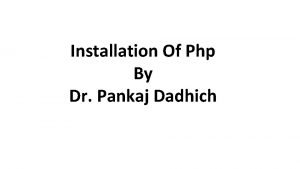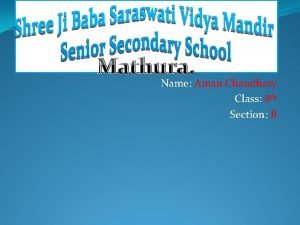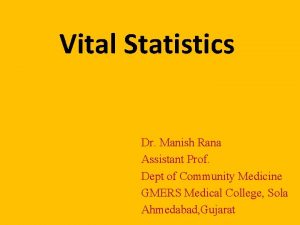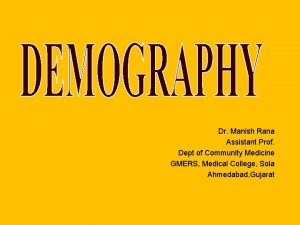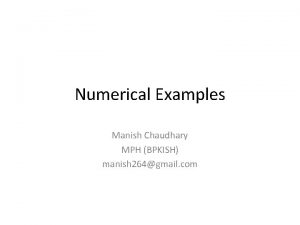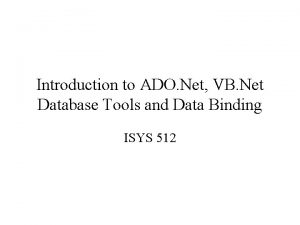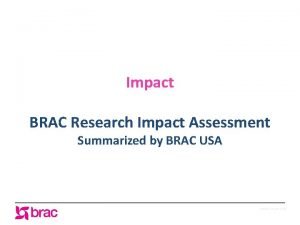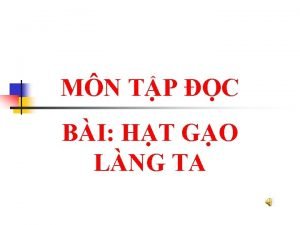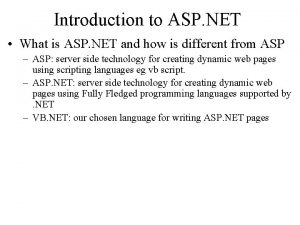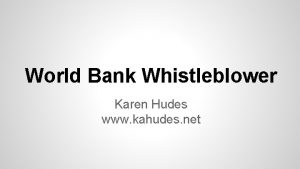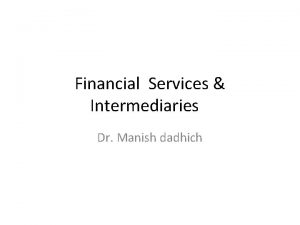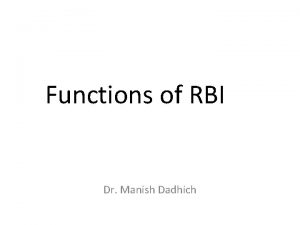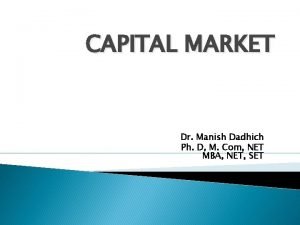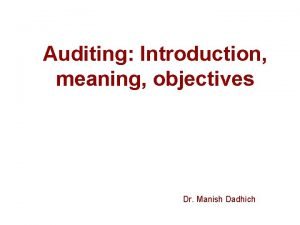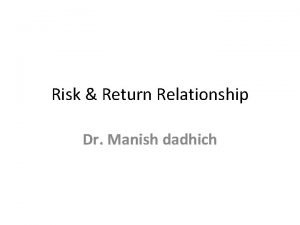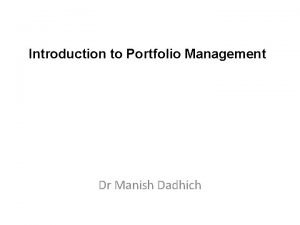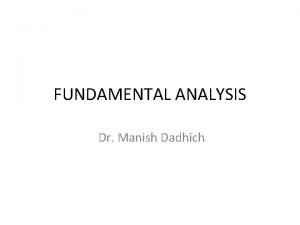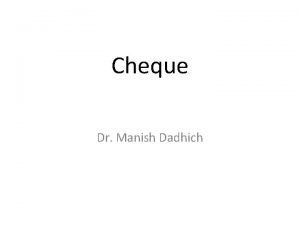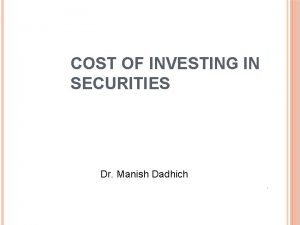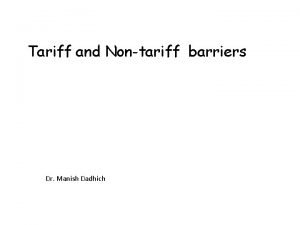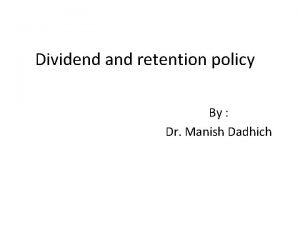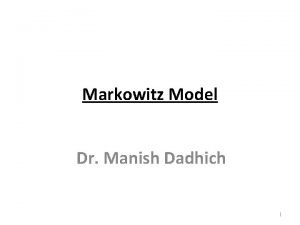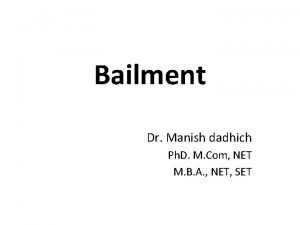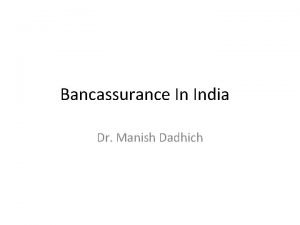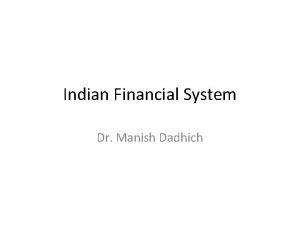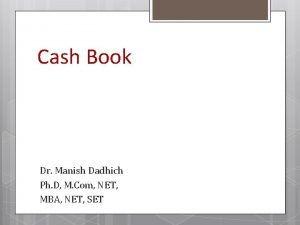Dr Manish Dadhich Ph D M Com NET






















- Slides: 22

Dr. Manish Dadhich Ph. D, M. Com, NET MBA, NET, SET

v As per RBI “A market for short terms financial assets that are close substitute for money, facilitates the exchange of money in primary and secondary market”. v A mechanism that deals with the lending and borrowing of short term funds. v A segment of the financial market in which financial instruments with high liquidity and very short maturities are traded. v As money became a commodity, the money market became a component of the financial markets for assets involved in short-term borrowing, lending, buying and selling with original maturities of one year or less. Trading in the money markets is done over the counter, is wholesale.

� As the name implies, it does not actually deal in cash or money but it actually deals with near money like treasury bills, banker’s acceptances, commercial papers etc drawn for short period not exceeding one year. � According to Crowther “the money market is the collective name given to the various firms and institutions that deal in the various grades of near money” � It helps in promotion of economic growth, production and distribution of overall economy.

Money Market Instruments Bill rediscounting Treasury Bills Inter-bank term money Certificates of Deposit Instr ume nts Commercial Paper Inter-bank participation Company Logo certificates

Characteristics of Money market � Arrangement of short term funds. � It’s not one market but collection of market. � Lending and borrowing activities. � Great network and large no. of participants. � Wholesale market of short term debt. � Trading is conducted through e-media not like floor of capital market � Tells about liquidity trend and interest rate. � Transaction without brokers.

Nature of Indian Money Market � Indian money market consists of both organized and unorganized sector. � RBI is controlling unit. � Unorganized market- money lenders, indigenous banks, chit funds etc. � Non-banking companies and intermediaries cater financial needs of industrial sectors. � Co-operative banks- rural agriculture need. � Indigenous banks remained outside the purview of RBI control. � ROI in unorganized is quite higher and very much prevalent in rural areas.

� Indian money market is isolated from foreign money market. � No brokers and intermediaries. � Call money is restricted to banks only. � Commercial banks maintain their- CRR, SLR, Repo rate, reverse repo rate. � No properly developed bill market. � Low level of per capita, higher liquidity preference, low propensity to serve.

Composition of Indian Money Market � 1. Money Market consists of a number of sub-markets which collectively constitute the money market. They are: Call Money: � Lending and borrowing transactions are carried out for one day that may or may not be renewed the next day. � Demand comes from commercial banks that need to meet requirements of CRR and SLR, whereas supply comes from commercial banks with excess funds, and FIs like IDBI, etc. � In India call money refers mostly to the inter-bank call money market. � Surplus banks in this market lend to the needy banks. � Call money- 1 day � Notice money 1 -14 days

2. The Treasury Bill Market: � Treasury bills are repaid at par on maturity. � Difference between amount paid by the traders at the time of purchase and the amount received on maturity represents the interest. � It deals in Treasury Bills of short term duration: 14 days, 182 days , 91 days, and 364 days. � They are issued by Government and largely held by RBI. � The treasury bills facilitate the financing of Central Government temporary deficits. � The rate of interest for treasury bills is determined by the market, depending on the demand supply of funds in the money market.

3. The Commercial Bill Market: � Short term paper or bill are bought and sold in the market. � Bill of exchange(BOE) is a written unconditional order signed by the drawer and to pay on demand, a fix amount of money. � Deals in bills of exchange and treasury bill, a seller draws a bill of exchange on the buyer to make payment within a certain period of time. � The bills can be domestic bills or foreign bills of exchange. � The commercial bills are purchased and discounted by commercial banks, and are rediscounted by FIs like EXIM Bank, SIDBI, etc.

4. Collateral Loan Market � When loans are offered against collateral securities like stock and bonds they are called C. L. � Loans are given for a short period i. e. few months. � Usually given by scheduled commercial banks and private parties in the market.

5. Acceptance money market � It refers to market for banker’s acceptance involved in trade transactions. � A banker’s acceptances is a draft drawn by an individual or firm upon a bank ordering to pay the order of a designated party or bearer. � Unlike cheque, banker acceptance are used in financing the movement of goods in international trade. � It can easily sold or discounted in the money market.

6. Commercial Paper market � It’s a quite a new instrument in the money market. � CPs are short term unsecured promissory notes with fixed maturity issued mostly by the lending, nationally reputed, credit worthy and highly rated large corporations. � Also known as Industrial papers, finance papers, corporate papers. � CP’s are issued in domestic as well as internationl financial markets. � Eg. Euro Commercial papers.

7. Certificate of Deposits � CD’s are bank deposit accounts which are transferable from one party to another. � They are marketable and negotiable short term instrument in bearer form. � Marketable receipt or registered form of funds deposited in a bank. � CD’s are interest bearing, maturity dated obligations of banks. � Technically they are a part of bank’s time deposits.

Institutions of money market m Central Bank Commercial Banks Non banking Financial Intermediari es Money Market Institutions Discount Houses Bill Brokers Dealer

Structure of Indian Money Market � ORGANISED MONEY STRUCTURE � UNORGANISED MONEY STRUCTURE

Organized Market v v v � v Reserve bank of India. DFHI (discount and finance house of India) Commercial banks: (i)Public sector banks SBI with 7 subsidiaries Cooperative banks 20 nationalized banks (ii)Private banks Indian Banks Foreign banks Development bank -- IDBI, IFCI, ICICI, NABARD, LIC, GIC, UTI etc.

�UNORGANISED v SECTOR Indigenous Banks v Money lenders v Unregulated Intermediaries

INDEGENEOUS BANKS v Private firms that receive deposits and give loans and thereby operate as banks v As activities are not regulated properly, they are unorganized segment v Broadly classified into 4 groups- GUJRATI SHROFFS, MULTANI SHROFFS, AND MARWARI KAYAS

MONEY LENDERS � Broadly classified into 3 categories: v PROFESSIONAL MONEYLENDERS v ITINERANT MONEY LENDERS v NON PROFESSIONAL MONEYLENDERS

UNREGULATED INTERMEDIARIES A) FINANCE COMPANIES- gives loans to the retailers, artisans and other self-employed persons B) CHIT FUNDS- are saving institutions C) NIDHIS- operate in unregulated credit market and provide kind of mutual benefit funds

Thanks
 Bài thơ mẹ đi làm từ sáng sớm
Bài thơ mẹ đi làm từ sáng sớm Cơm
Cơm Dr pankaj dadhich
Dr pankaj dadhich Importance of equity
Importance of equity Aman chaudhary
Aman chaudhary Manish parashar utah
Manish parashar utah Dr manish rana
Dr manish rana Pylomyotomy
Pylomyotomy Manish gupta
Manish gupta Dr manish rana
Dr manish rana 6e2111
6e2111 Manish chaudhary mathura
Manish chaudhary mathura Ado.net vb.net
Ado.net vb.net Achmed lach net ich krieg mein tach net
Achmed lach net ich krieg mein tach net Schedule source enterprise
Schedule source enterprise Brack net
Brack net Vodafone forum coimbra
Vodafone forum coimbra Tinthac net
Tinthac net What is aspnet
What is aspnet [email protected]
[email protected] Net bio dyn
Net bio dyn Karen hudes world bank whistleblower
Karen hudes world bank whistleblower Tikcdn.net
Tikcdn.net


